2. 长安大学成矿作用及其动力学实验室, 西安 710054
2. Laboratory of Mineralization and Dynamics, Chang'an University, Xi'an 710054, China
花岗伟晶岩型矿床贡献了全球约一半Li产量(Benson et al., 2017),历史上曾是Be金属唯一的工业来源(Norton et al., 1958),还伴生Nb、Ta、Sn、W等稀有金属矿产(Černý and Ercit, 2005; Simmons and Webber, 2008; Linnen et al., 2012; McCauley and Bradley, 2014; Chen et al., 2020)。花岗伟晶岩的成因主要存在两种不同的认识,即岩浆分异成因(Černý, 1991a; Černý, 1992; London, 2005) 和部分熔融与分离结晶的混合成因(Shearer et al., 1992; Roda-Robles et al., 1999),争议的焦点在于物源的不同。岩浆分异模式认为,稀有金属伟晶岩由残余的花岗岩熔体演化而来(Jahns and Burnham, 1969; Selway et al., 2005; London, 2018),但除了似伟晶岩壳(Haapala and Lukkari, 2005; Müller et al., 2017)和极少数伟晶岩区如土耳其Aksu-Pushtiru锂云母亚型伟晶岩(Černý et al., 2005b),世界上绝大多数稀有金属伟晶岩几乎都观察不到与之有直接成因联系的花岗岩。混合模型则认为稀有金属伟晶岩并非都源自同一岩浆,而是由变质沉积岩经不同程度部分熔融形成的多批岩浆独立分异演化而成(Shearer et al., 1992; Roda-Robles et al., 1999)。前人通过伟晶岩的全岩成分(Barros and Menuge, 2016; Garate-Olave et al., 2017)、矿物地球化学特征(Pan and Breaks, 1997; Alfonso et al., 2003; Neiva et al., 2008; Kontak and Kyser, 2009; Wise and Brown, 2010; Vieira et al., 2011; Roda-Robles et al., 2012; Baijot et al., 2012; Hulsbosch et al., 2014; Michallik et al., 2017; Garate-Olave et al., 2017; Liu et al., 2019; Xiong et al., 2019; Zhou et al., 2019)、以及瑞利分离结晶模型判断伟晶岩的“母岩”和定量研究伟晶岩岩浆的分异演化程度(Hulsbosch et al., 2014; Barros and Menuge, 2016; Garate-Olave et al., 2017; London, 2022),等等。然而,前人建立岩浆分异成因模型时,要么所选样品矿化类型单一(Barros and Menuge, 2016; Garate-Olave et al., 2017),要么对稀有金属伟晶岩不作区分(Hulsbosch et al., 2014; London, 2022),忽视了同一地区不同矿化的稀有金属伟晶岩矿物学观察和年代学数据的有效结合,也未明确瑞利模型的应用前提。
中国阿尔泰造山带的卡鲁安-阿祖拜伟晶岩田是我国宝石(主要是海蓝宝石)、稀有金属(Li、Be、Nb、Ta)资源的重要产地之一(邹天人和李庆昌, 2006; 马占龙等, 2015; Zhang et al., 2016; Zhou et al., 2018; Feng et al., 2019)。伟晶岩在区域上分布具有显著的分带性,离哈龙复式岩体从近到远分别为贫矿/无矿伟晶岩、富Be伟晶岩、富Li伟晶岩、石英脉,被认为是通过花岗质岩浆分离结晶形成(赵振华等, 1991; 邹天人和李庆昌, 2006)。但年代学研究显示,岩体形成时代为早泥盆世,伟晶岩形成时代为中三叠世-早侏罗世,其巨大的年代差异排除了它们之间的成因联系(Lü et al., 2012; 周天怡, 2015; 马占龙等, 2015; Zhang et al., 2016; Zhou et al., 2018; Feng et al., 2019; 刘涛等, 2020)。2018年课题组在矿田南部群库尔路线地质调查时发现了淡色白云母花岗岩岩株,其成岩时代(240.1Ma; 高景刚等, 待发表)与稀有金属伟晶岩相近,从岩株的展布特征、矿物组成等分析,可能与稀有金属伟晶岩存在成因联系,这为我们研究该区伟晶岩的成岩演化过程提供了契机。本文选择卡鲁安-阿祖拜地区不同稀有矿化的伟晶岩,研究区内花岗岩、伟晶岩中贯通性造岩矿物白云母的成分演化,分析岩体与伟晶岩的成因联系,并建立瑞利分离结晶模型,旨在探讨云母成分变化趋势对伟晶岩与花岗岩的成因联系和岩浆演化过程的合理指示。
1 地质背景阿尔泰造山带地处于中亚造山带中部,南以额尔齐斯大断裂为界,北至西伯利亚板块,西接哈萨克斯坦地块,东邻蒙古国阿尔泰地区(曲国胜和何国琦, 1992; Windley et al., 2002, 2007; Xiao et al., 2004; Long et al., 2008, 2010; Sun et al., 2008; 孙敏等, 2009)。区域构造以NW-SE向断裂带为主,平面上呈向北西部撒开、向南东部收敛,同时发育多期显著的变质、变形(赵志忠等, 2002)。根据沉积建造、岩浆作用、变质作用及构造变形强度、期次、构造层位出露等特征,曲国胜和何国琦(1992)将阿尔泰造山带分为5个构造带,而Windley et al. (2002)则进一步将其划分为6个地体(图 1a)。阿尔泰伟晶岩主要分布于北阿尔泰山地体、中阿尔泰山地体、琼库尔-阿巴宫地体。勘探资料表明已发现了十多万条伟晶岩脉(赵振华等, 1991),其中数千条具有不同程度的稀有金属矿化或白云母矿化,依据控矿因素可划分为哈龙-青河稀有金属成矿亚带和加曼哈巴-大喀拉苏稀有金属成矿亚带(邹天人和李庆昌, 2006),进一步分9个矿集区(图 1a)。阿尔泰地区稀有金属成矿作用主要分为4期:奥陶纪-早志留世(476~436Ma)、晚泥盆世(~370Ma)、二叠纪(296~258Ma)和三叠纪-侏罗纪(250~151Ma),其中以三叠纪-侏罗纪(250~151Ma)为主要成矿期,处于陆内环境的区域大规模伸展的地球动力学背景(杨富全等, 2018)。
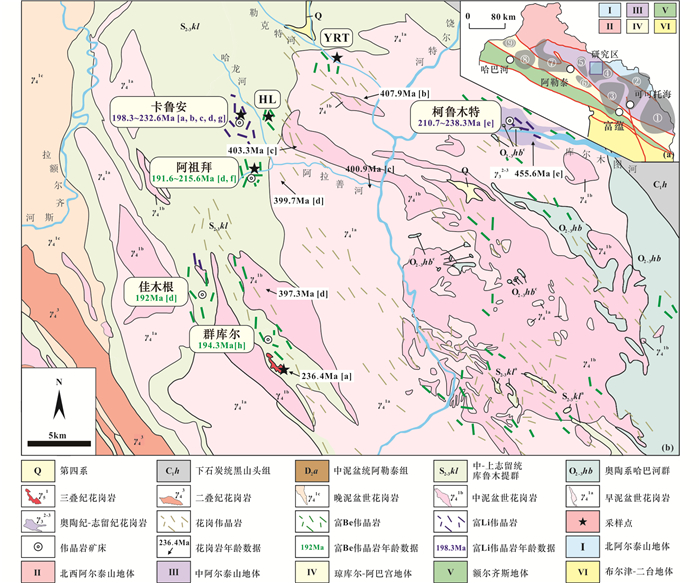
|
图 1 柯鲁木特-吉得克矿集区地质略图(据新疆有色地质勘查局,2010①实测修编) 矿集区:①青河矿集区;②可可托海矿集区;③库威-结别特矿集区;④柯鲁木特-吉得克矿集区;⑤卡拉额尔齐斯矿集区;⑥大喀拉苏-可可西尔矿集区;⑦小卡拉苏-切别林矿集区;⑧海流滩-也留曼矿集区;⑨加曼哈巴矿集区. 文献来源:[a](高景刚等,待发表);[b](刘涛等, 2020);[c](马占龙等, 2015);[d](Zhang et al., 2016);[e](Lü et al., 2012);[f](周天怡, 2015);[g](Feng et al., 2019);[h](Zhou et al., 2018) Fig. 1 Geological map of Kelumute-Jideke district Metallogenic districts: 1-Qinghe; 2-Keketuohai; 3-Kuwei-Jiebiete; 4-Kelumute-Jideke; 5-Kala'e'erqisi; 6-Dakalasu-Kekexier; 7-Xiaokalasu-Qiebielin; 8-Hailiutan-Yeliuman; 9-Jiamanhaba. [a] (Gao et al., unpublished data); [b] (Liu et al., 2020); [c] (Ma et al., 2015); [d] (Zhang et al., 2016); [e] (Lü et al., 2012); [f] (Zhou, 2015); [g] (Feng et al., 2019); [h] (Zhou et al., 2018) |
① 新疆有色地质勘查局.2010. 1:20万新疆福海县卡鲁安地区区域地质矿产图
2 矿田地质特征新疆阿尔泰卡鲁安-阿祖拜伟晶岩田地处中阿尔泰山地体,分布在哈龙复式花岗岩体外接触带西侧,属于哈龙-青河稀有金属成矿亚带柯鲁木特-吉得克矿集区的一部分(图 1a, b)。出露地层为中-上志留统库鲁木提群,原岩受区域变质作用和热接触变质作用的影响,围绕哈龙复式岩体并在其西侧发育比较完整的递增变质带,形成各类片岩(马占龙等, 2015; Zhang et al., 2016)。褶皱构造有哈龙复式背斜,断裂多为近北西向断裂,次为东西向断裂,大量的伟晶岩脉发育在哈龙背斜的倾没端、东西向断裂与北西向断裂的复合地带及与之相应的次级构造(邹天人和李庆昌, 2006)。矿区周边出露的岩浆岩主要为哈龙复式岩基和伟晶岩。哈龙复式岩基(又称阿拉善岩体)主体岩性为片麻状黑云母花岗岩、二云母花岗岩,成岩时代为早泥盆世(407.9~397.3Ma;马占龙等, 2015; 刘涛等, 2020)。2018年作者在南部群库尔伟晶岩调查中发现了白云母花岗岩株,经野外路线调查及遥感卫片解译,该岩株出露面积约为0.8km2,受北西向构造控制,呈岩株状侵入到中-上志留统库鲁木提群中(图 1b、图 2a),并具有不同程度的糜棱岩化,利用锆石U-Pb获得成岩时代为中三叠世(240.1±2.1Ma;高景刚等,待发表)。矿区内伟晶岩脉发育,主要侵位于中-上志留统库鲁木提群黑云母石英片岩中。根据主要稀有金属矿化类型,将含矿伟晶岩分为富Be伟晶岩、富Li伟晶岩。
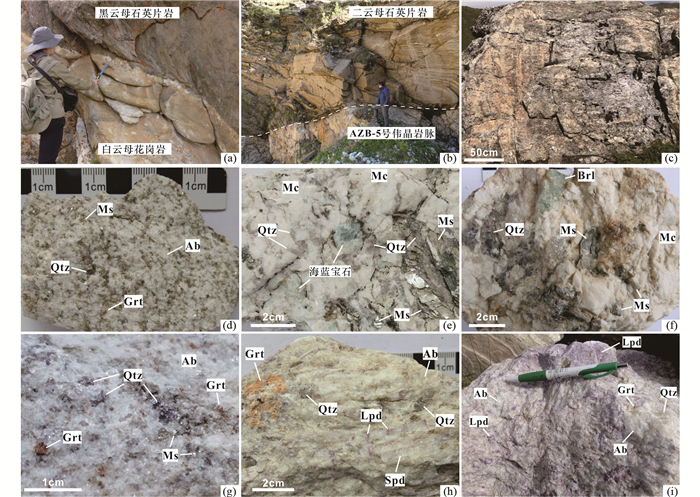
|
图 2 卡鲁安-阿祖拜地区白云母花岗岩、伟晶岩典型矿物和结构的野外照片 (a)群库尔白云母花岗岩侵入黑云母石英片岩中;(b)阿祖拜Be伟晶岩侵入二云母石英片岩中;(c)805号伟晶岩脉细粒、中粗粒韵律结构带;(d)群库尔白云母花岗岩,由微斜条纹长石、石英、钠长石、白云母、以及少量的石榴子石组成;(e)阿祖拜Be伟晶岩文象结构带中的海蓝宝石、白云母;(f)勒克特河下游地区Be伟晶岩文象结构带中的浅绿色绿柱石、白云母;(g)803号伟晶岩脉细粒边缘带,由钠长石、石英、白云母和少量石榴子石组成;(h)650号伟晶岩脉中间带中的橙色石榴子石、锂辉石,紫色锂云母沿节理交代锂辉石;(i)650号伟晶岩脉中间带的紫色锂云母集合体.Qtz-石英;Ab-钠长石;Spd-锂辉石;Lpd-锂云母;Mc-微斜长石;Ms-白云母;Grt-石榴子石;Brl-绿柱石 Fig. 2 Field photographs showing typical textures and mineralogy of the muscovite granite and pegmatites in Kalu'an-Azubai field (a) the Qiongkuer muscovite granite intruded into the biotite-quartz schist; (b) the Azubai Be-rich pegmatite dike intruded into the mica-quartz schist; (c) No.805 pegmatite with alternating coarse-grained and fine-grained layers; (d) the Qiongkuer muscovite granite dominated by microcline, quartz, albite, muscovite, and accessory garnet; (e) aquamarine and muscovite in the wall zone of the Azubai Be-rich pegmatite; (f) light green beryl and muscovite in the wall zone of the YRT Be-rich pegmatite; (g) the border zone of No.803 pegmatite dominated by albite, quartz, muscovite, and accessory garnet; (h) spodumene and orange spessartine in the intermediate zone of No.650 pegmatite where spodumene is partially replaced by purple lepidolite; (i) purple lepidolite aggregate from the intermediate zone of the No.650 pegmatite. Qtz-quartz; Ab-albite; Spd-spodumene; Lpd-lepidolite; Mc-microcline; Ms-muscovite; Grt-garnet; Brl-Beryl |
富Be伟晶岩主要位于阿祖拜、群库尔、哈龙河东岸、勒克特河下游地区,该类伟晶岩以Be矿化为主,Nb-Ta矿化次之。阿祖拜富Be伟晶岩侵位于二云石英片岩及含电气石二云石英片岩中(图 2b),走向为近南北向。这些伟晶岩的分带性较好,可分为细粒边缘带(< 5cm)、具文象结构的绿柱石-白云母-微斜长石-石英带、粗粒至巨晶块状微斜长石-石英带及钠长石交代结构(叶片状钠长石集合体以及细粒石榴子石-钠长石组合),部分脉体局部出露石英核。其中,文象结构带中的绿柱石多为海蓝宝石且均匀分布于带内,以个大、完整、少裂纹、颜色蓝而鲜如海水而闻名(王登红等, 2000)。除含有石英、微斜长石、钠长石、白云母及绿柱石(海蓝宝石)等造岩矿物外,阿祖拜富Be伟晶岩尚含有电气石、石榴子石、锆石及磷酸盐矿物(主要为磷灰石、磷铁矿、磷锰矿等),但不含铌钽铁矿。哈龙河东岸(HL)的富Be伟晶岩与阿祖拜富Be伟晶岩较为相似,其分带性较好,具有纹层状细晶岩带、具文象结构的绿柱石-白云母-微斜长石-石英带、粗粒至巨晶块状微斜长石-石英带。除含有石英、微斜长石、钠长石、白云母及绿柱石等造岩矿物外,副矿物还包括电气石、石榴子石、锆石、磷酸盐矿物(主要为磷灰石、磷锂铁矿等)及铌钽铁矿。比较特殊的是,勒克特河下游地区(YRT)的富Be伟晶岩侵入哈龙花岗岩体的西北缘,与黑云母花岗岩呈侵入接触关系,并主要由石英、微斜长石、白云母和海蓝宝石组成(Feng et al., 2019)。
富Li伟晶岩位于卡鲁安、柯鲁木特、佳木根(开)地区。该类伟晶岩以Li、Be矿化为主,Nb-Ta矿化次之。卡鲁安富Li伟晶岩脉往往成群出现,呈NE向或近NS向分布。NE向分布代表矿脉有803、807号脉等,有一定的垂向分带,顶部为锂云母-钠长石型伟晶岩,深部出现锂辉石-钠长石型伟晶岩。近NS向代表矿脉有650、802、805号脉等,其中650号伟晶岩脉结构分带清晰,主要造岩矿物为石英、微斜长石、钠长石、锂辉石及锂云母(图 2h, i),副矿物则包括锰铝榴石、铌钽铁矿、绿柱石(海蓝宝石)及锆石。除650号脉外,其他富Li伟晶岩中的锂矿物主要为锂辉石,锂云母含量较少;805号脉呈透镜状,结构带分带性较差,可见细粒结构带和中粗粒结构带呈韵律分布(图 2c),局部有块体微斜长石。石英-钠长石-锂辉石结构带是该矿脉的主体,位于矿脉的中心部位,锂辉石为薄板状,长轴垂直脉壁,除锂辉石外,还见铌钽铁矿。
3 样品描述本次研究的样品主要采自新发现的群库尔白云母花岗岩株以及阿祖拜富Be伟晶岩、卡鲁安富Li伟晶岩等。
(1) 含石榴子石白云母花岗岩
样品采自群库尔白云母花岗岩株(QK),岩性为含石榴子石白云母花岗岩。岩石呈灰白色,全晶质等粒结构,块状构造,有一定程度的糜棱岩化。组成矿物为微斜条纹长石(40%~45%)、钠长石(25%~30%)、石英(20%~25%)、白云母(10%~15%)、以及少量的石榴子石(3%~5%)。矿物粒径1~3mm,其中微斜条纹长石为板状,发育条纹结构和格子双晶;钠长石呈板状,聚片双晶发育;石英为他形粒状,有的可见波状消光。白云母呈白色片状(图 2d),片径为0.5~1mm,受应力作用发生一定形变,成分均一(图 3a)。石榴子石为红褐色粒状、均质体;副矿物有磷灰石和锆石。
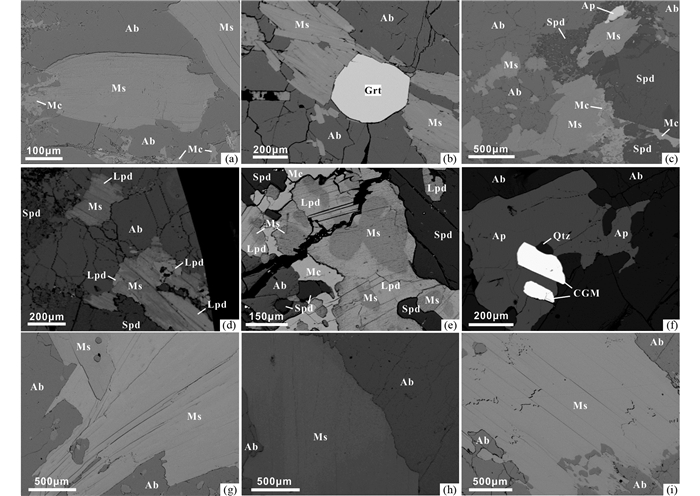
|
图 3 卡鲁安-阿祖拜地区白云母花岗岩、富Be伟晶岩、富Li伟晶岩中云母的背散射图像 (a)群库尔白云母花岗岩中的白云母(挠曲);(b)803号伟晶岩脉边缘带的白云母,与钠长石、石榴子石共生;(c)807号伟晶岩脉中间带的白云母,与锂辉石、钠长石共生;(d)805号伟晶岩脉中间带的白云母,与锂云母呈不规则分带;(e)650号伟晶岩脉中间带的白云母,与锂云母呈补丁分带;(f)哈龙河东岸地区富Be伟晶岩的铌钽铁矿,与磷灰石共生;(g)阿祖拜富Be伟晶岩中成分均一的白云母;(h)哈龙河东岸地区富Be伟晶岩中成分均一的白云母;(i)勒克特河下游地区富Be伟晶岩中成分均一的白云母. CGM-铌铁族矿物;Ap-磷灰石 Fig. 3 BSE images of micas from the muscovite granite, Be-rich pegmatites and Li-rich pegmatites in Kalu'an-Azubai field (a) flexural muscovite of the Qiongkuer muscovite granite; (b) muscovite associated with garnet and albite in No.803 pegmatite; (c) muscovite associated with spodumene and albite in No.807 pegmatite; (d) mica from the intermediate zone of No.805 pegmatite. Dark muscovite cores are overgrown by light rims with lepidolite; (e) mica from the intermediate zone of No.650 pegmatite. Dark muscovite cores are overgrown by light rims with lepidolite; (f) CGM associated with apatite in HL Be-rich pegmatite; (g) homogeneous muscovite of the AZB Be-rich pegmatite; (h) homogeneous muscovite of the HL Be-rich pegmatite; (i) homogeneous muscovite of the YRT Be-rich pegmatite. CGM-columbite group minerals; Ap-apatite |
(2) 富Be伟晶岩
富Be伟晶岩样品主要采自阿祖拜(AZB)1号、4号、5号伟晶岩脉。部分样品采自哈龙河东岸地区(HL)和勒克特河下游地区(YRT),具体位置见图 1。所有白云母样品均采自外侧带(文象结构带),其矿物组合为绿柱石-白云母-微斜长石-石英。矿物成分主要为微斜长石(50%~60%)、石英(30%~35%),白云母(5%~10%)、少量为绿柱石(1%~2%)、石榴子石(0~1%)、电气石(0~1%),副矿物有锆石、磷酸盐矿物(磷灰石、磷铁矿、磷锰矿等)。绿柱石呈淡蓝-黄绿色(图 2f),较为自形,粒度在20×40mm~5×10mm,在阿祖拜地区多为海蓝宝石(图 2e)。白云母呈片状(图 2e, f),片径≥20mm,多与钠长石、微斜长石共生,成分均一,同样无分带特征(图 3g-i)。不同的是,哈龙河东岸(HL)的富Be伟晶岩还产出铌钽铁矿。这些铌钽铁矿多为半自形粒状,与磷灰石、石英共生,粒径约为0.1~0.3mm(图 3f)。
(3) 富Li伟晶岩
富Li伟晶岩采自卡鲁安(KLA)650、801、802、804、805、806、807、808号伟晶岩脉,分析的白云母大多采自边缘带,少量采自中间带。边缘带一般 < 5cm,矿物组合为钠长石-石英-白云母-石榴子石(图 2g),具有细粒结构,块状构造,矿物组分主要为钠长石(60%)、石英(30%)、白云母(12%)、石榴子石(3%)。白云母呈片状,片径 < 1mm,常与石榴子石共生,其成分均一,无明显分带(图 3b)。中间带为伟晶岩脉主体,矿物组合为锂辉石-钠长石-(微斜长石)-石英,具有伟晶结构,块状构造。岩石矿物组成主要包括锂辉石(25%~30%)、石英(20%~25%)、钠长石(15%~20%)、微斜长石(15%~20%),白云母(5%~10%)、少量为锰铝榴石(1%~2%)、绿柱石(< 1%),副矿物有磷灰石、铌钽铁矿及锆石,未见电气石。锂辉石呈自形柱状、板状,粒径0.5~3cm,部分锂辉石沿节理被粉色锂云母交代(图 2h);镜下可观察到简单双晶与聚片双晶,具有熔蚀结构(图 3c),并发育毛发状锂辉石。铌钽铁矿一般为自形至半自形粒状,与锂辉石、白云母共生,粒径为0.1~0.3mm,背散射照片下常见振荡分区或扇形分区或两者兼有(Feng et al., 2019)。白云母呈片状,片径≤2mm,与钠长石、锂辉石、铌钽铁矿共生,其成分变化明显,表现为不同的成分分带形式,如白云母与锂云母呈不规则分带(图 3d)或补丁状分带(图 3e)产出。
4 测试方法和分析结果 4.1 测试方法所有云母样品的测试均在长安大学成矿作用及其动力学实验室完成。主量元素分析(EPMA)的实验仪器为日本电子株式会社8100型电子探针(JEOL-JXA-8100)。实验条件如下:探针分析时的加速电压和样品表面电流分别为15kV和15nA,电子束斑直径为2μm。所分析元素的X光谱线及相应标样如下:Si Kα(石英)、Fe Kα(磁铁矿)、Ca Kα(硅灰石)、Na Kα(钠长石)、K Kα(钾长石)、Mg Kα(橄榄石)、Mn Kα(红钛锰矿)、Ti Kα(红钛锰矿)、Al Kα(刚玉)、P Kα(磷灰石)、F Kα(萤石)。白云母、锂云母中Li的含量根据云母的F含量(Tischendorf et al., 1997)或Mg含量(Tischendorf et al., 1999)计算。
白云母花岗岩、富Li伟晶岩中云母的微量元素分析(LA-ICP-MS)的实验仪器为联接美国Photon Machines公司193nm气态准分子激光剥蚀系统的安捷伦7700E型四级杆等离子体质谱仪。激光剥蚀系统采用氦气作载气、氩气为补偿气调节灵敏度,氦气流量为0.87L/min,激光频率为8Hz,测试点束斑直径为50μm,单脉冲能量为4.9J/cm2,单次测量时间为50s,背景测量时间为30s。分析步骤为:在薄片中选择已进行探针分析的云母,先测试2次标样NIST 610,之后每分析8次云母样品,重复测试2次标样NIST 610,使用NIST 610和NIST 612分别作为主要外标和次要外标,以Si(其含量由探针分析测得)作为内标,进行云母微量元素含量计算。测试数据的离线处理(包括对样品和空白信号的选择、仪器灵敏度漂移校正、元素含量计算)采用软件ICPMSDataCal(Liu et al., 2008; Liu et al., 2010a)完成,详细的仪器操作条件和数据处理方法见(Liu et al., 2008; Liu et al., 2010a; Liu et al., 2010b)。富Be伟晶岩白云母的微量元素分析的实验仪器为美国热电X-7型电感耦合等离子体质谱分析仪(ICP-MS)。样品选择片径>2cm的云母,在60℃下洗涤、干燥,用玛瑙磨具研磨至200目。检测依据为GB/T14506.30—2010,分析精度约为2%~5%。
4.2 主量元素分析结果白云母花岗岩、富Be伟晶岩、富Li伟晶岩的云母主量元素成分结果列于表 1。基于云母成分的分类图解(图 4)表明:白云母花岗岩中白云母均为白云母;富Be伟晶岩的白云母均为白云母;而富Li伟晶岩的白云母大多为白云母,少量为多硅白云母、含锂多硅白云母和铁锂云母。
|
|
表 1 卡鲁安-阿祖拜地区群库尔白云母花岗岩、富Be伟晶岩、富Li伟晶岩云母主量元素含量(wt%) Table 1 Major element contents of micas from the muscovite granite, Be-rich pegmatites and Li-rich pegmatites in Kalu'an-Azubai field (wt%) |
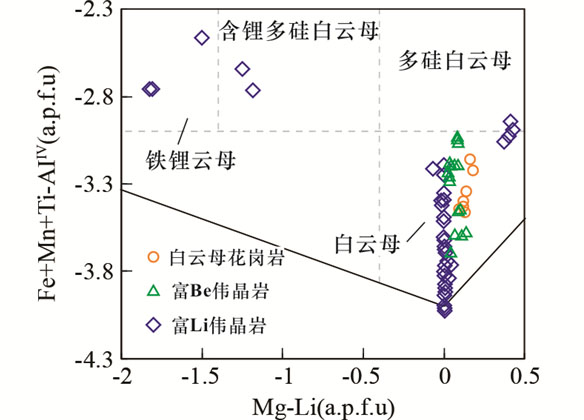
|
图 4 卡鲁安-阿祖拜地区白云母花岗岩、富Be伟晶岩、富Li伟晶岩云母的Mg-Li对Fe+Mn+Ti-AlⅣ图解(据Tischendorf et al., 1997) Fig. 4 Mg-Li vs. Fe+Mn+Ti-AlⅣ classification showing the composition of micas from muscovite granite, Be-rich pegmatites and Li-rich pegmatites in Kalu'an-Azubai field (modified after Tischendorf et al., 1997) |
通过LA-ICP-MS及ICP-MS分析测试获得云母的微量元素成分(表 2,详细数据见电子版附表 1)。结果表明(图 5),白云母花岗岩、富Be伟晶岩、富Li伟晶岩的白云母共同表现为较低的Be、Sc、Cr、Zr、Ba、Ta、Pb、V含量(< 100×10-6)和较高的Rb含量(>1000×10-6)。不同的是,富Li伟晶岩具有相对更高的大离子亲石元素(Li、Rb、Zn、Cs)和更低的高场强元素(Nb)含量显著区别于富Be伟晶岩、白云母花岗岩(图 5),而白云母花岗岩、富Be伟晶岩则较为相似,其大离子亲石元素和高场强元素含量没有显著区别。具体表现为富Li伟晶岩具有较高的Li(1042×10-6~20812×10-6)、Rb(4616×10-6~7961×10-6)、Zn(933×10-6~2592×10-6)含量,中等的Cs含量(92.0×10-6~381×10-6),较低的Nb(27.4×10-6~97.6×10-6)含量;白云母花岗岩具有较高的Rb(1185×10-6~1658×10-6)含量,中等的Li(357×10-6~870×10-6)、Zn(124×10-6~283×10-6)、Nb(145×10-6~180×10-6)含量,较低的Cs(22.2×10-6~133×10-6)含量;富Be伟晶岩具有较高的Rb(1312×10-6~2878×10-6)含量,中等的Li(491×10-6~1782×10-6)、Zn(154×10-6~268×10-6)、Nb(268×10-6~438×10-6)含量,较低的Cs(75.7×10-6~111×10-6)含量。
|
|
表 2 卡鲁安-阿祖拜地区群库尔白云母花岗岩、富Be伟晶岩、富Li伟晶岩代表性云母微量元素成分(×10-6) Table 2 Trace element concentrations of representative micas from the muscovite granite, Be-rich pegmatites and Li-rich pegmatites in Kalu'an-Azubai field (×10-6) |
|
|
附表 1 卡鲁安-阿祖拜地区群库尔白云母花岗岩、富Be伟晶岩、富Li伟晶岩云母微量成分(×10-6) Appendix Table 1 Trace element composition of micas from the muscovite granite, Be-rich pegmatites and Li-rich pegmatites in Kalu'an-Azubai field (×10-6) |
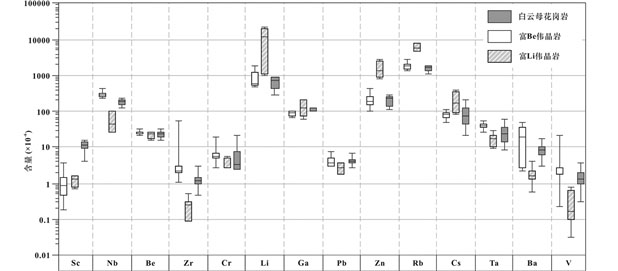
|
图 5 卡鲁安-阿祖拜地区白云母花岗岩、富Be伟晶岩、富Li伟晶岩云母微量元素含量箱状图 Fig. 5 Box plots showing the distribution of trace elements for micas from muscovite granite, Be-rich pegmatites and Li-rich pegmatites in Kalu'an-Azubai field |
根据锆石和铌钽铁矿U-Pb年代学测试结果(表 3),柯鲁木特-吉得克矿集区花岗岩成岩时代分为晚奥陶世(455.6~445.6Ma)、早泥盆世(407.9~397.3Ma)和中三叠世(240.1Ma)三个时期,而卡鲁安-阿祖拜伟晶岩田的稀有矿化时代为中三叠世-早侏罗世(232.6~191.6Ma;图 6)。根据野外调研和室内综合研究,我们认为群库尔白云母花岗岩(240.1Ma)与伟晶岩之间的联系更为密切。统计获得富Li伟晶岩结晶年龄为232.6~198.3Ma,峰值区间为225~220Ma;富Be伟晶岩结晶年龄为215.6~191.6Ma,峰值区间为195~190Ma,其最早、最晚的结晶年龄和年龄峰值比富Li伟晶岩小约17Ma、7Ma和30Ma。London (2018)总结认为伟晶岩的温度变化范围可粗略地分为三组(< 350℃、350~550℃、>550℃),而流体/熔体包裹体研究则表明以熔体为主的岩浆阶段温度范围在720~500℃(Thomas and Davidson, 2016)。考虑到锆石U-Pb同位素体系封闭温度为≥800℃(Pidgeon and Aftalion, 1978; Lee et al., 1997; Dahl, 1997),铌钽铁矿U-Pb同位素体系封闭温度为500~700℃(Li et al., 2019),上述结晶年龄基本可以表征为伟晶岩的侵位年龄。换言之,富Li伟晶岩岩浆侵位的开始、结束时间以及最活跃的阶段均早于富Be伟晶岩岩浆。Nabelek et al. (2010)研究表明,伟晶岩粗大晶体的形成,与伟晶岩岩浆的快速侵位和富含H2O、Li、B、F、P等挥发分密切相关。由于伟晶岩岩浆经历了快速侵位的过程,其侵位年龄在一定程度上也能反映其形成时代。综上所述,花岗岩、伟晶岩形成的先后顺序为:白云母花岗岩→富Li伟晶岩→富Be伟晶岩(图 6)。这一顺序(图 6)显然不太符合典型的岩浆分异模式(Černý, 1991b; London, 2005; London, 2018),即同一岩浆依次分异演化形成白云母花岗岩→富Be伟晶岩→富Li伟晶岩。
|
|
表 3 柯鲁木特-吉得克矿集区花岗岩和卡鲁安-阿祖拜伟晶岩田稀有伟晶岩类型、产状及年龄统计 Table 3 Type, shape and age statistics of granite in the Kelumute-Jideke district and pegmatites in Kalu'an-Azubai field |
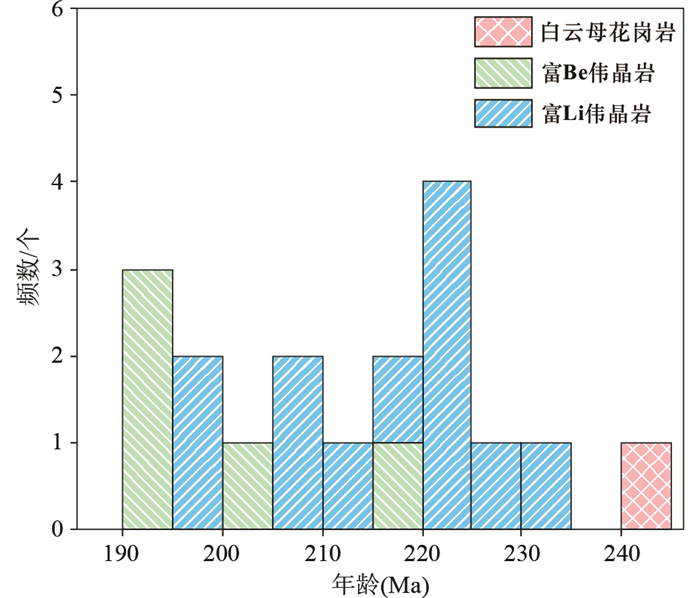
|
图 6 卡鲁安-阿祖拜地区白云母花岗岩、富Be伟晶岩、富Li伟晶岩年龄频数分布直方图 Fig. 6 Age histogram of the muscovite granite, Be-rich pegmatites and Li-rich pegmatites in Kalu'an-Azubai field |
岩相学研究表明,区内富Li伟晶岩发育大量橙色石榴子石、锂云母而缺乏磷酸盐矿物,而富Be伟晶岩则相对富磷灰石、磷铁矿,这意味着形成二者的熔体在成分上有较大差异,分别属于贫P但富Al、F的体系以及富P体系(Sánchez-Muñoz et al., 2017),表明富Be伟晶岩、富Li伟晶岩可能并非来自同一岩浆源。Hf同位素数据结果显示,白云母花岗岩εHf(t)值的变化幅度大,为-4.75~2.66,均值为-0.18(高景刚等,待发表);富Be伟晶岩εHf(t)值的变化幅度大,为-1~6.3,均值为2.51(马占龙等, 2015; Zhang et al., 2016);富Li伟晶岩εHf(t)值的变化幅度小,为-0.6~2.5,均值为1.29(Zhang et al., 2016)。εHf(t)值总体表现为白云母花岗岩 < 富Li伟晶岩 < 富Be伟晶岩,与白云母花岗岩、稀有金属伟晶岩形成的时代顺序呈明显的负相关。这表明了它们的物源组成存在一定变化趋势,可能与岩浆演化过程中外来物质加入的程度不同有关,也可能是岩浆起源于相似而非同一源区。综上所述,卡鲁安-阿祖拜地区花岗岩与稀有金属伟晶岩不太符合典型的岩浆分异模式,很可能并非同源演化的直接产物。
已有研究显示,阿尔泰地区稀有金属伟晶岩大多与赋矿花岗岩不存在成因联系(杨富全等, 2018),其成因与造山运动过程中加厚的不成熟地壳物质因伸展减压背景下小比例减压熔融(深熔作用)有关(张辉等, 2019; Lü et al., 2021)。而利用伟晶岩的混合成因模式(Shearer et al., 1992; Roda Robles et al., 1999),解释卡鲁安-阿祖拜地区稀有金属伟晶岩的成因时,则更加合理。当变质源区部分熔融程度较低时,富含粘土矿物的变质泥质岩可能先于蒸发岩发生部分熔融,Li优先进入熔体中形成较为富Li的花岗质熔体;而当部分熔融程度增大时,则蒸发岩也发生部分熔融形成富Be、P的花岗质熔体,最终表现为富Be伟晶岩的结晶年龄大多小于富Li伟晶岩,而εHf(t)值的变化幅度也大于富Li伟晶岩。
5.2 瑞利分离结晶模型和云母成分变化趋势对伟晶岩成因及演化的指示本区稀有金属伟晶岩中存在Li的类质同象置换趋势(图 7a, b)。在富Be伟晶岩、富Li伟晶岩中,白云母均有AlLiR-2的类质同象置换趋势(Roda-Robles et al., 2006),即八面体的Fe、Mg、Mn被Li、Al置换(图 7a),但并不足以改变白云母的类型。而富Li伟晶岩中则具有白云母Si2LiAl-3的类质同象置换趋势(Roda-Robles et al., 2006),具体表现为白云母中四面体和八面体的Al被置换为Si和Li(图 7b),并形成含锂多硅白云母、铁锂云母(图 4)。这反映了富Be伟晶岩、富Li伟晶岩均存在Li富集的演化趋势,而在富Li伟晶岩中最为显著,出现了锂云母、锂辉石等独立矿物。
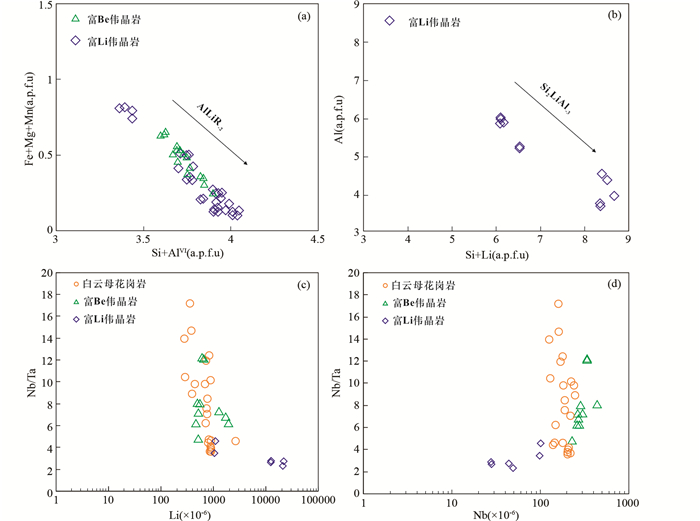
|
图 7 卡鲁安-阿祖拜地区白云母花岗岩、富Be伟晶岩、富Li伟晶岩云母的演化趋势图 (a)(Si+AlⅥ)-(Fe+Mg+Mn)图解(Roda-Robles et al., 2006);(b)(Si+Li)-Al图解(Roda-Robles et al., 2006);(c)Li-Nb/Ta图解;(d)Nb-Nb/Ta图解 Fig. 7 Discrimination diagrams and the evolutionary trend of micas from the muscovite granite, Be-rich pegmatites and Li-rich pegmatites in Kalu'an-Azubai field (a) plot of Si+AlⅥ vs. Fe+Mg+Mn (Roda-Robles et al., 2006); (b) plot of Si+Li vs. Al (Roda-Robles et al., 2006); (c) plot of Li vs. Nb/Ta; (d) plot of Nb vs. Nb/Ta |
此外,从白云母花岗岩→富Be伟晶岩→富Li伟晶岩,白云母还存在Nb含量和Nb/Ta值降低的趋势(图 7c, d)。前人研究发现,从过铝质花岗岩→伟晶岩,其全岩成分的演化趋势表现为Ta相对于Nb更明显的增加,而Nb/Ta值降低(Stepanov et al., 2014),反映了Ta的富集和Nb的消耗,可能归因于白云母(Stepanov et al., 2014)和铌铁矿(Linnen and Keppler, 1997)的结晶。岩相学观察显示白云母花岗岩不含铌钽铁矿,富Be伟晶岩仅样品HL有少量的铌钽铁矿,富Li伟晶岩则发育大量铌钽铁矿。这表明了白云母花岗岩、富Be伟晶岩中白云母Nb/Ta值的变化更可能与白云母结晶有关,其较大的变化范围则代表可能经历了不同程度的分离结晶作用;富Li伟晶岩白云母较低的Nb/Ta值可能与丰富的铌钽铁矿有关,其演化趋势为Ta#=Ta/(Ta+Nb)值增加(Feng et al., 2019),可能指示更高的岩浆分异演化程度。
根据瑞利方程(Rayleigh and Ramsay, 1896),Neumann et al. (1954)建立了岩浆的分离结晶模型,该关系可表示为:

|
(①) |
其中,矿物j中元素i的浓度与结晶程度F的函数关系如下:

|
(②) |
Hulsbosch et al. (2014)通过对造岩矿物(长石、云母和电气石)的大离子亲石元素(K、Rb、Cs)和稀土元素(REE)的研究,建立了适用于单矿物的瑞利分离结晶模型,用以判断伟晶岩脉群的“母岩”和定量研究伟晶岩岩浆的分异演化程度。经过推导(Hulsbosch et al., 2014),由花岗岩残余岩浆分离结晶形成的伟晶岩,其造岩矿物j中大离子亲石元素浓度CijSol与母岩浆中大离子亲石元素的浓度C0, iLiq应符合以下关系(i=1、2、3,代表了三种元素):

|
(③) |
其形式为:y=A·x+B。斜率A为:

|
(④) |
其y轴的截距B为:

|
(⑤) |
上述公式中,C0, iLiq=母熔体中元素i的初始浓度、CiLiq=残余熔体中元素i的浓度、F=结晶程度(0 < F < 1)、Di=∑jXjKd, ij=元素i的全岩分配系数、Xj=在结晶矿物组合中,矿物j的质量分数、∑jXj=1、Kd, ij=
本次模拟选择的白云母来自阿祖拜富Be伟晶岩,其锆石U-Pb加权平均年龄为191.6Ma(Zhang et al., 2016);富Li伟晶岩中的白云母及锂云母则选自卡鲁安805号脉(KLA No.805),其铌钽铁矿U-Pb加权平均年龄为224.3Ma(Feng et al., 2019)。同时,为正确建立瑞利分离结晶模型,严格按照前人的总结,选取了白云母样品(Allègre et al., 1977; Van Lichtervelde et al., 2008; Hulsbosch et al., 2014)。经过计算,白云母实测值投点呈显著的线性趋势(图 8a, b),线性拟合度良好,而利用公式④、⑤计算得出斜率A、截距B值(表 4),与散点图趋势线的斜率、截距值差异不大,满足建立瑞利型分离结晶模型的条件(Hulsbosch et al., 2014)。对此,设结晶程度(F)为变量,模拟初始熔体结晶程度从1%变为99%(F=0.01~0.99)的过程,并利用公式②计算白云母中K、Rb、Cs的理论含量,建立白云母大离子亲石元素的瑞利分离结晶正演模型(图 8c, d;详细数据见电子版附表 2),计算过程的相关参数见表 4。结果表明(图 8c),可由初始花岗质岩浆经分离结晶作用依次形成白云母花岗岩→富Be伟晶岩→富Li伟晶岩。
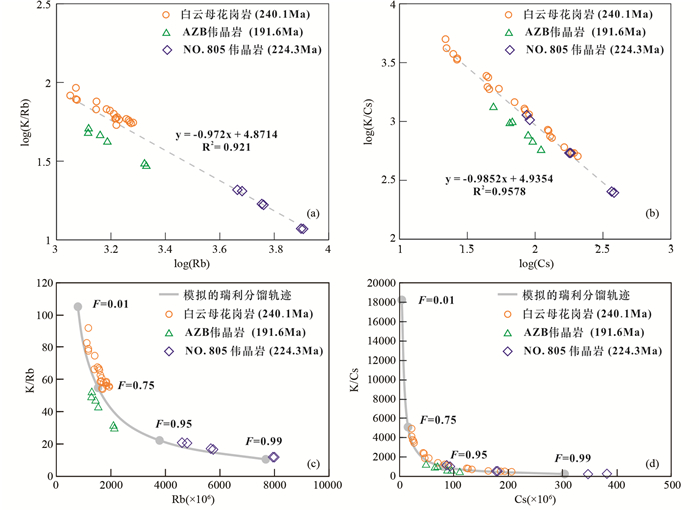
|
图 8 卡鲁安-阿祖拜地区白云母花岗岩、富Be伟晶岩(AZB)、富Li伟晶岩(KLA No.805)瑞利分离结晶作用判别图解(a、b)和模拟的瑞利分离结晶轨迹(c、d) Fig. 8 Discrimination diagrams (a, b) and the modelled trajectories (c, d) for Rayleigh fractional crystallization from muscovite granite, Be-rich pegmatites (AZB) and Li-rich pegmatites (KLA No.805) in Kalu'an-Azubai field |
|
|
表 4 瑞利分离结晶模型参数 Table 4 Parameters applied in Rayleigh fractionation modelling |
|
|
附表 2 初始花岗质岩浆不同结晶度下白云母的大离子亲石元素含量模拟结果 Appendix Table 2 Results of LILE contents for micas by Rayleigh fractionation modelling with the initial granitic magma |
但该顺序明显与它们的实测年龄顺序不符(表 3),矿物学、同位素证据也不太支持它们均为同源演化的直接产物。前人研究表明,白云母的Li、Rb、Cs、F、Ba、Sn、Zn含量和K/Rb值反映了伟晶岩的演化趋势和分异演化程度,即伴随演化程度增高,云母Li、Rb、Cs、F含量升高,Ba含量、K/Rb值降低(Černý et al., 1985; Černý, 1991a; Foord et al., 1995; Wise, 1995; Roda et al., 1995; Kile and Foord, 1998; Pesquera et al., 1999; Clarke and Bogutyn, 2003; Černý et al., 2005a; Roda-Robles et al., 2006; Roda et al., 2007; Viana et al., 2007; Vieira et al., 2011)。
对比世界上各著名伟晶岩产区发现,即使是不同产地、不同类型的伟晶岩,其白云母K/Rb值和Cs含量总体还是呈现出负相关的线性趋势(图 9),说明不同伟晶岩的白云母稀有元素含量与只与伟晶岩自身的演化程度密切相关,并不能简单通过其元素含量或比值关系就判定伟晶岩之间存在成因和演化关系。综上所述,使用瑞利分离结晶模型判断伟晶岩的“母岩”和定量研究岩浆分异演化程度时,对花岗岩、伟晶岩时空分布合理性和同源性判断应为第一要素,尤其是面对复杂矿化、多期次侵位的稀有金属伟晶岩。
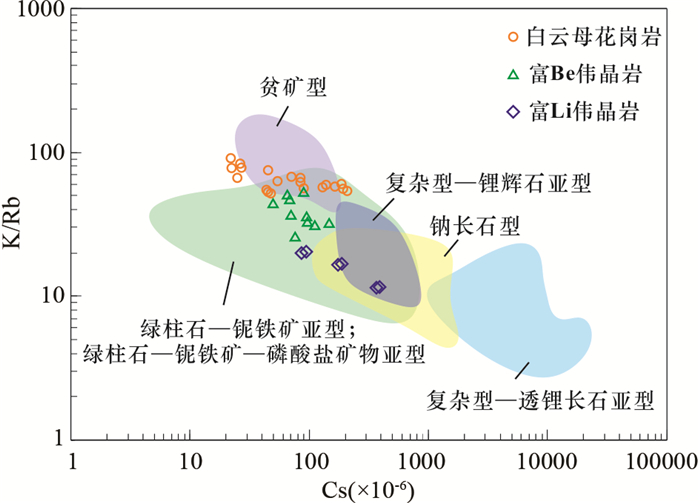
|
图 9 卡鲁安-阿祖拜地区白云母花岗岩、富Be伟晶岩、富Li伟晶岩白云母K/Rb-Cs图解 数据来源:贫矿型、绿柱石-铌铁矿亚型、绿柱石-铌铁矿-磷酸盐矿物亚型、复杂型-锂辉石亚型、钠长石型伟晶岩均产自西班牙Cap de Creus伟晶岩区(Alfonso et al., 2003)和阿根廷Totoral伟晶岩区(Oyarzábal et al., 2009);复杂型-透锂长石亚型伟晶岩产地则为加拿大Tanco超大型稀有金属矿床(Van Lichtervelde et al., 2008) Fig. 9 K/Rb vs. Cs content diagram for micas from the muscovite granite, Be-rich pegmatites and Li-rich pegmatites in Kalu'an-Azubai field Data sources: barren pegmatites, beryl-columbite subtype, beryl-columbite-phosphate subtype, complex type of spodumene subtype and albite type pegmatites from the Cap de Creus pegmatite field in Spain(Alfonso et al., 2003) and the Totoral pegmatite field in Argentina(Oyarzábal et al., 2009); complex type of petalite subtype pegmatites at Tanco, Canada(Van Lichtervelde et al., 2008) |
(1) 卡鲁安-阿祖拜地区富Be伟晶岩、富Li伟晶岩的白云母均存在Li富集的演化趋势,而富Li伟晶岩中出现了锂云母等独立矿物。从白云母花岗岩→富Be伟晶岩→富Li伟晶岩,白云母总体表现为Nb含量和Nb/Ta值降低,可能代表了白云母花岗岩、富Be伟晶岩经历了不同程度的分离结晶作用,也可能代表了富Li伟晶岩的岩浆分异演化程度更高。
(2) 利用瑞利分离结晶模型判断复杂稀有金属矿化伟晶岩的成因及演化关系时,花岗岩-伟晶岩系统具有合理的时空分布、源自同一岩浆源的特征是正确建立的瑞利分离结晶模型的前提。
致谢 本次野外调研、取样、收集地质资料等工作获得了新疆有色金属工业(集团)有限责任公司的大力支持;样品处理与实验测试得到了长安大学成矿作用及其动力学实验室谭细娟博士和刘民武博士的指导和帮助;在本文写作过程中,与新疆维吾尔自治区地质调查院李平高级工程师进行了有益的讨论;匿名审稿专家给出了宝贵的修改意见;在此对他们表示诚挚的感谢!
Adam J and Green T. 2006. Trace element partitioning between mica- and amphibole-bearing garnet lherzolite and hydrous basanitic melt: 1. Experimental results and the investigation of controls on partitioning behaviour. Contributions to Mineralogy and Petrology, 152(1): 1-17 DOI:10.1007/s00410-006-0085-4
|
Alfonso P, Melgarejo JC, Yusta I and Velasco F. 2003. Geochemistry of feldspars and muscovite in granitic pegmatite from the Cap de Creus field, Catalonia, Spain. The Canadian Mineralogist, 41(1): 103-116 DOI:10.2113/gscanmin.41.1.103
|
Allègre CJ, Treuil M, Minster JF, Minster B and Albarède F. 1977. Systematic use of trace element in igneous process. Contributions to Mineralogy and Petrology, 60(1): 57-75 DOI:10.1007/BF00372851
|
Baijot M, Hatert F and Philippo S. 2012. Mineralogy and geochemistry of phosphates and silicates in the Sapucaia pegmatite, Minas Gerais, Brazil: Genetic implications. The Canadian Mineralogist, 50(6): 1531-1554 DOI:10.3749/canmin.50.6.1531
|
Barros R and Menuge JF. 2016. The origin of spodumene pegmatites associated with the Leinster granite in Southeast Ireland. The Canadian Mineralogist, 54(4): 847-862 DOI:10.3749/canmin.1600027
|
Bea F, Pereira MD and Stroh A. 1994. Mineral/leucosome trace-element partitioning in a peraluminous migmatite (a laser ablation-ICP-MS study). Chemical Geology, 117(1): 291-312
|
Benson TR, Coble MA., Rytuba JJ and Mahood GA. 2017. Lithium enrichment in intracontinental rhyolite magmas leads to Li deposits in caldera basins. Nature Communications, 8: 270 DOI:10.1038/s41467-017-00234-y
|
Černý P, Meintzer RE and Anderson AJ. 1985. Extreme fractionation in rare-element granitic pegmatites; selected examples of data and mechanisms. The Canadian Mineralogist, 23(3): 381-421
|
Černý P. 1991a. Rare-element granitic pegmatites. Part Ⅰ: Anatomy and internal evolution of pegmatitic deposits. Geoscience Canada, 18(2): 49-67
|
Černý P. 1991b. Rare-element granitic pegmatites. Part Ⅱ: Regional to global environments and petrogenesis. Geoscience Canada, 18(2): 68-81
|
Černý P. 1992. Geochemical and petrogenetic features of mineralization in rare-element granitic pegmatites in the light of current research. Applied Geochemistry, 7(5): 393-416 DOI:10.1016/0883-2927(92)90002-K
|
Černý P and Ercit TS. 2005. The classification of granitic pegmatites revisited. The Canadian Mineralogist, 43(6): 2005-2026 DOI:10.2113/gscanmin.43.6.2005
|
Černý P, Linnen R and Samson I. 2005a. The Tanco rare-element pegmatite deposit, Manitoba: regional context, internal anatomy, and global comparisons. Geological Association of Canada, GAC Short Course, 17: 127-158
|
Černý P, Masau M, Goad BE and Ferreira K. 2005b. The Greer Lake leucogranite, Manitoba, and the origin of lepidolite-subtype granitic pegmatites. Lithos, 80(1-4): 305-321 DOI:10.1016/j.lithos.2003.11.003
|
Chen YC, Pei RF and Wang DH. 2020. On minerogenetic series: The third discussion. Acta Geologica Sinica, 94(1): 1-9 DOI:10.1111/1755-6724.14396
|
Clarke DB and Bogutyn PA. 2003. Oscillatory epitactic-growth zoning in biotite and muscovite from the Lake Lewis leucogranite, South Mountain Batholith, Nova Scotia, Canada. The Canadian Mineralogist, 41(4): 1027-1047 DOI:10.2113/gscanmin.41.4.1027
|
Dahl PS. 1997. A crystal-chemical basis for Pb retention and fission track annealing systematics in U-bearing minerals, with implications for geochronology. Earth and Planetary Science Letters, 150(3/4): 277-290
|
Feng YG, Liang T, Zhang Z, Wang YQ, Zhou Y, Yang XQ, Gao JG, Wang H and Ding K. 2019. Columbite U-Pb geochronology of Kalu'an lithium pegmatites in Northern Xinjiang, China: Implications for genesis and emplacement history of rare-element pegmatites. Minerals, 9(8): 456 DOI:10.3390/min9080456
|
Foord E, Černý P, Jackson L, Sherman DM and Eby R. 1995. Mineralogical and geochemical evolution of micas from miarolitic pegmatites of the anorogenic Pikes Peak batholith, Colorado. Mineralogy and Petrology, 55(1): 1-26 DOI:10.1007/BF01162576
|
Garate-Olave I, Müller A, Roda-Robles E, Gil-Crespo P and Pesquera A. 2017. Extreme fractionation in a granite-pegmatite system documented by quartz chemistry: The case study of Tres Arroyos (Central Iberian Zone, Spain). Lithos, 286: 162-174
|
Haapala I and Lukkari S. 2005. Petrological and geochemical evolution of the Kymi stock, a topaz granite cupola within the Wiborg rapakivi batholith, Finland. Lithos, 80(1): 347-362
|
Hulsbosch N, Hertogen J, Dewaele S, André L and Muchez P. 2014. Alkali metal and rare earth element evolution of rock-forming minerals from the Gatumba area pegmatites (Rwanda): Quantitative assessment of crystal-melt fractionation in the regional zonation of pegmatite groups. Geochimica et Cosmochimica Acta, 132: 349-374 DOI:10.1016/j.gca.2014.02.006
|
Icenhower J and London D. 1996. Experimental partitioning of Rb, Cs, Sr, and Ba between alkali feldspar and peraluminous melt. American Mineralogist, 81(5-6): 719-734 DOI:10.2138/am-1996-5-619
|
Jahns RH and Burnham CW. 1969. Experimental studies of pegmatite genesis; l, A model for the derivation and crystallization of granitic pegmatites. Economic Geology, 64(8): 843-864 DOI:10.2113/gsecongeo.64.8.843
|
Jolliff BL, Papike JJ and Shearer CK. 1992. Petrogenetic relationships between pegmatite and granite based on geochemistry of muscovite in pegmatite wall zones, Black Hills, South Dakota, USA. Geochimica et Cosmochimica Acta, 56(5): 1915-1939 DOI:10.1016/0016-7037(92)90320-I
|
Kile DE and Foord EE. 1998. Micas from the Pikes Peak Batholith and its cogenetic granitic pegmatites, Colorado; optical properties, composition, and correlation with pegmatite evolution. The Canadian Mineralogist, 36(2): 463-482
|
Kontak DJ and Kyser TK. 2009. Nature and origin of an LCT-suite pegmatite with late-stage sodium enrichment, Brazil Lake, Yarmouth County, Nova Scotia. Ⅱ. Implications of stable isotopes (δ18O, δD) for magma source, internal crystallization and nature of sodium metasomatism. The Canadian Mineralogist, 47(4): 745-764 DOI:10.3749/canmin.47.4.745
|
Lee JKW, Williams IS and Ellis DJ. 1997. Pb, U and Th diffusion in natural zircon. Nature, 390: 159-161 DOI:10.1038/36554
|
Linnen RL and Keppler H. 1997. Columbite solubility in granitic melts: Consequences for the enrichment and fractionation of Nb and Ta in the Earth's crust. Contributions to Mineralogy and Petrology, 128(2): 213-227
|
Linnen RL, Van Lichtervelde M and Černý PJE. 2012. Granitic pegmatites as sources of strategic metals. Elements, 8(4): 275-280 DOI:10.2113/gselements.8.4.275
|
Li P, Li JK, Chou IM, Wang DH and Xiong X. 2019. Mineralization epochs of granitic rare-metal pegmatite deposits in the Songpan-Ganzê Orogenic Belt and their implications for orogeny. Minerals, 9(5): 280 DOI:10.3390/min9050280
|
Liu LJ, Wang DH, Hou JL, Zhao Y and Zhang YJ. 2019. New data on lithium isotopic geochemistry of the No.X03 lithium vein in the Jiajika super-large lithium deposit, Sichuan, China. Acta Geologica Sinica, 93(6): 1983-1984 DOI:10.1111/1755-6724.14312
|
Liu T, Tian SH, Wang DH, Zhang YJ, Li XF, Hou KJ, Jiekeng KLMH, Zhang ZL, Wang YQ, Zhao Y and Qin Y. 2020. Genetic relationship between granite and pegmatite in Kalu'an hard-rock-type lithium deposit in Xinjiang: Results from zircon U-Pb dating, Hf-O isotopes and whole-rock geochemistry. Acta Geologica Sinica, 94(11): 3293-3334 (in Chinese with English abstract)
|
Liu YS, Hu ZC, Gao S, Günther D, Xu J, Gao CG and Chen HH. 2008. In situ analysis of major and trace elements of anhydrous minerals by LA-ICP-MS without applying an internal standard. Chemical Geology, 257(1): 34-43
|
Liu YS, Gao S, Hu ZC, Gao CG, Zong KQ and Wang DB. 2010a. Continental and oceanic crust recycling-induced melt-peridotite interactions in the Trans-North China Orogen: U-Pb dating, Hf isotopes and trace elements in zircons from mantle xenoliths. Journal of Petrology, 51(1-2): 537-571 DOI:10.1093/petrology/egp082
|
Liu YS, Hu ZC, Zong KQ, Gao CG, Gao S, Xu J and Chen HH. 2010b. Reappraisement and refinement of zircon U-Pb isotope and trace element analyses by LA-ICP-MS. Chinese Science Bulletin, 55(15): 1535-1546 DOI:10.1007/s11434-010-3052-4
|
London D. 2005. Granitic pegmatites: an assessment of current concepts and directions for the future. Lithos, 80(1-4): 281-303 DOI:10.1016/j.lithos.2004.02.009
|
London D. 2018. Ore-forming processes within granitic pegmatites. Ore Geology Reviews, 101: 349-383 DOI:10.1016/j.oregeorev.2018.04.020
|
London D. 2022. A Rayleigh model of cesium fractionation in granite-pegmatite systems. American Mineralogist: Journal of Earth and Planetary Materials, 107(1): 82-91
|
Long PE. 1978. Experimental determination of partition coefficients for Rb, Sr and Ba between alkali feldspar and silicate liquid. Geochimica et Cosmochimica Acta, 42(6): 833-846 DOI:10.1016/0016-7037(78)90096-0
|
Long XP, Sun M, Yuan C, Xiao WJ and Cai KD. 2008. Early Paleozoic sedimentary record of the Chinese Altai: Implications for its tectonic evolution. Sedimentary Geology, 208(3-4): 88-100 DOI:10.1016/j.sedgeo.2008.05.002
|
Long XP, Yuan C, Sun M, Xiao WJ, Zhao GC, Wang YJ, Cai KD, Xia XP and Xie LW. 2010. Detrital zircon ages and Hf isotopes of the Early Paleozoic flysch sequence in the Chinese Altai, NW China: New constrains on depositional age, provenance and tectonic evolution. Tectonophysics, 480(1-4): 213-231 DOI:10.1016/j.tecto.2009.10.013
|
Lü ZH, Zhang H, Tang Y and Guan SJ. 2012. Petrogenesis and magmatic-hydrothermal evolution time limitation of Kelumute No.112 pegmatite in Altay, Northwestern China: Evidence from zircon U-Pb and Hf isotopes. Lithos, 154: 374-391 DOI:10.1016/j.lithos.2012.08.005
|
Lü ZH, Zhang H and Tang Y. 2021. Anatexis origin of rare metal/earth pegmatites: Evidences from the Permian pegmatites in the Chinese Altai. Lithos, 380-381: 105865 DOI:10.1016/j.lithos.2020.105865
|
Ma ZL, Zhang H, Tang Y, Lü ZH, Zhang X and Zhao JY. 2015. Zircon U-Pb geochronology and Hf isotopes of pegmatites from the Kaluan mining area in the Altay, Xinjiang and their genetic relationship with the Halong granite. Geochimica, 44(1): 9-26 (in Chinese with English abstract)
|
McCauley A and Bradley DC. 2014. The global age distribution of granitic pegmatites. The Canadian Mineralogist, 52(2): 183-190 DOI:10.3749/canmin.52.2.183
|
Michallik RM, Wagner T, Fusswinkel T, Heinonen JS and Heikkilä P. 2017. Chemical evolution and origin of the Luumäki gem beryl pegmatite: Constraints from mineral trace element chemistry and fractionation modeling. Lithos, 274: 147-168
|
Müller A, Romer RL and Pedersen RB. 2017. The Sveconorwegian Pegmatite Province: Thousands of pegmatites without parental granites. The Canadian Mineralogist, 55(2): 283-315 DOI:10.3749/canmin.1600075
|
Nabelek PI, Whittington AG and Sirbescu M. 2010. The role of H2O in rapid emplacement and crystallization of granite pegmatites: resolving the paradox of large crystals in highly undercooled melts. Contributions to Mineralogy and Petrology, 160(3): 313-325 DOI:10.1007/s00410-009-0479-1
|
Nash WP and Crecraft HR. 1985. Partition coefficients for trace elements in silicic magmas. Geochimica et Cosmochimica Acta, 49(11): 2309-2322 DOI:10.1016/0016-7037(85)90231-5
|
Neiva AM, Gomes ME, Ramos JM and Silva PB. 2008. Geochemistry of granitic aplite-pegmatite sills and their minerals from Arcozelo da Serra area (Gouveia, central Portugal). European Journal of Mineralogy, 20(4): 465-485 DOI:10.1127/0935-1221/2008/0020-1827
|
Neumann H, Mead J and Vitaliano CJ. 1954. Trace element variation during fractional crystallization as calculated from the distribution law. Geochimica et Cosmochimica Acta, 6(2): 90-99
|
Norton JJ, Griffitts WR and Wilmarth VR. 1958. Geology and resources of beryllium in the United States. Geological Survey, Denver
|
Oyarzábal J, Galliski Má and Perino E. 2009. Geochemistry of K-feldspar and muscovite in rare-element pegmatites and granites from the Totoral Pegmatite Field, San Luis, Argentina. Resource Geology, 59(4): 315-329 DOI:10.1111/j.1751-3928.2009.00100.x
|
Pan Y and Breaks FW. 1997. Rare-earth elements in fluorapatite, Separation Lake area, Ontario; evidence for S-type granite-rare-element pegmatite linkage. The Canadian Mineralogist, 35(3): 659-671
|
Pesquera A, Torres-Ruiz J, Gil-Crespo PP and Velilla N. 1999. Chemistry and genetic implications of tourmaline and Li-F-Cs micas from the Valdeflores area (Cáceres, Spain). American Mineralogist, 84(1-2): 55-69 DOI:10.2138/am-1999-1-206
|
Philpotts JA and Schnetzler CC. 1970. Phenocryst-matrix partition coefficients for K, Rb, Sr and Ba, with applications to anorthosite and basalt genesis. Geochimica et Cosmochimica Acta, 34(3): 307-322 DOI:10.1016/0016-7037(70)90108-0
|
Pidgeon RT and Aftalion M. 1978. Cogenetic and inherited zircon U-Pb systems in granites: Paleozoic granites of Scotland and England. Geology Journal, 10: 183-220
|
Qu GS and He GQ. 1992. The orogeny in the Altaides. Acta Geologica Sinica, 66(3): 193-205 (in Chinese with English abstract)
|
Rayleigh L and Ramsay W. 1896. Theoretical considerations respecting the separation of gases by diffusion and similar processes. The London, Edinburgh, and Dublin Philosophical Magazine and Journal of Science, 42(259): 493-498 DOI:10.1080/14786449608620944
|
Roda E, Peréz AP and Roldán FV. 1995. Micas of the muscovite-lepidolite series from the Fregeneda pegmatites (Salamanca, Spain). Mineralogy and Petrology, 55(1-3): 145-157 DOI:10.1007/BF01162585
|
Roda E, Keller P, Pesquera A and Fontan F. 2007. Micas of the muscovite-lepidolite series from Karibib pegmatites, Namibia. Mineralogical Magazine, 71(1): 41-62 DOI:10.1180/minmag.2007.071.1.41
|
Roda-Robles E, Perez AP, Roldan FV and Fontan F. 1999. The granitic pegmatites of the Fregeneda area (Salamanca, Spain): Characteristics and petrogenesis. Mineralogical Magazine, 63(4): 535-558 DOI:10.1180/002646199548709
|
Roda-Robles E, Pesquera A, Gil-Crespo PP, Torres-Ruiz J and De Parseval P. 2006. Mineralogy and geochemistry of micas from the Pinilla de Fermoselle pegmatite (Zamora, Spain). European Journal of Mineralogy, 18(3): 369-377 DOI:10.1127/0935-1221/2006/0018-0369
|
Roda-Robles E, Pesquera A, Gil-Crespo PP and Torres-Ruiz J. 2012. The Puentemocha beryl-phosphate granitic pegmatite, Salamanca, Spain: Internal structure, petrography and mineralogy. The Canadian Mineralogist, 50(6): 1573-1587 DOI:10.3749/canmin.50.6.1573
|
Sánchez-Muñoz L, Müller A, Andrés SL, Martin RF, Modreski PJ and de Moura OJM. 2017. The P-Fe diagram for K-feldspars: A preliminary approach in the discrimination of pegmatites. Lithos, 272-273: 116-127 DOI:10.1016/j.lithos.2016.10.030
|
Selway JB, Breaks FW and Tindle AG. 2005. A review of rare-element (Li-Cs-Ta) pegmatite exploration techniques for the Superior Province, Canada, and large worldwide tantalum deposits. Exploration and Mining Geology, 14(1-4): 1-30 DOI:10.2113/gsemg.14.1-4.1
|
Shearer CK, Papike JJ and Jolliff BL. 1992. Petrogenetic links among granites and pegmatites in the Harney Peak rare-element granite-pegmatite system, Black Hills, South Dakota. The Canadian Mineralogist, 30(3): 785-809
|
Simmons WBS and Webber KL. 2008. Pegmatite genesis: State of the art. European Journal of Mineralogy, 20(4): 421-438 DOI:10.1127/0935-1221/2008/0020-1833
|
Stepanov A, Mavrogenes JA, Meffre S and Davidson P. 2014. The key role of mica during igneous concentration of tantalum. Contributions to Mineralogy and Petrology, 167(6): 1-8
|
Sun M, Yuan C, Xiao WJ, Long XP, Xia XP, Zhao GC, Lin SF, Wu FY and Kröner A. 2008. Zircon U-Pb and Hf isotopic study of gneissic rocks from the Chinese Altai: Progressive accretionary history in the early to middle Palaeozoic. Chemical Geology, 247(3): 352-383
|
Sun M, Long XP, Cai KD, Jiang YD, Wang BY, Yuan C, Zhao GC, Xiao WJ and Wu FY. 2009. Early Palaeozoic ridge subduction in the Chinese Altai: Insight from the abrupt change in zircon Hf isotopic compositions. Science in China (Series D), 39(7): 935-948 DOI:10.1007/s11430-009-0110-3
|
Thomas R and Davidson P. 2016. Revisiting complete miscibility between silicate melts and hydrous fluids, and the extreme enrichment of some elements in the supercritical state-Consequences for the formation of pegmatites and ore deposits. Ore Geology Reviews, 72: 1088-1101 DOI:10.1016/j.oregeorev.2015.10.004
|
Tischendorf G, Gottesmann B, Förster HJ and Trumbull RB. 1997. On Li-bearing micas: Estimating Li from electron microprobe analyses and an improved diagram for graphical representation. Mineralogical Magazine, 61(409): 809-834 DOI:10.1180/minmag.1997.061.409.05
|
Tischendorf G, Förster HJ and Gottesmann B. 1999. The correlation between lithium and magnesium in trioctahedral micas: Improved equations for Li2O estimation from MgO data. Mineralogical Magazine, 63(1): 57-74 DOI:10.1180/002646199548312
|
Van Hinsberg VJ. 2011. Preliminary experimental data on trace-element partitioning between tourmaline and silicate melt. The Canadian Mineralogist, 49(1): 153-163 DOI:10.3749/canmin.49.1.153
|
Van Lichtervelde M, Grégoire M, Linnen RL, Béziat D and Salvi S. 2008. Trace element geochemistry by laser ablation ICP-MS of micas associated with Ta mineralization in the Tanco pegmatite, Manitoba, Canada. Contributions to Mineralogy and Petrology, 155(6): 791-806 DOI:10.1007/s00410-007-0271-z
|
Viana RR, Jordt-Evangelista H and Stern WB. 2007. Geochemistry of muscovite from pegmatites of the Eastern Brazilian pegmatite province: A clue to petrogenesis and mineralization potential. European Journal of Mineralogy, 19(5): 745-755 DOI:10.1127/0935-1221/2007/0019-1760
|
Vieira R, Roda-Robles E, Pesquera A and Lima A. 2011. Chemical variation and significance of micas from the Fregeneda-Almendra pegmatitic field (Central-Iberian Zone, Spain and Portugal). American Mineralogist, 96(4): 637-645 DOI:10.2138/am.2011.3584
|
Wang DH, Chen YC, Zou TR, Xu ZG, Li HQ, Chen W, Chen FW and Tian F. 2000. 40Ar-39Ar dating for the Azubai rare metal-gem deposit in Altay, Xinjiang: New evidence for Yanshanian mineralization of rare metals. Geological Review, 46(3): 307-311 (in Chinese with English abstract)
|
Windley BF, Kröner A, Guo J, Qu G, Li Y and Zhang C. 2002. Neoproterozoic to Paleozoic geology of the Altai orogen, NW China: New zircon age data and tectonic evolution. The Journal of geology, 110(6): 719-737 DOI:10.1086/342866
|
Windley BF, Alexeiev D, Xiao W, Kröner A and Badarch G. 2007. Tectonic models for accretion of the Central Asian Orogenic Belt. Journal of the Geological Society, 164(1): 31-47 DOI:10.1144/0016-76492006-022
|
Wise MA and Brown CD. 2010. Mineral chemistry, petrology and geochemistry of the Sebago granite-pegmatite system, southern Maine, USA. Journal of Geosciences, 55(1): 3-26
|
Xiao WJ, Windley BF, Badarch G, Sun S, Li JL, Qin KZ and Wang ZH. 2004. Palaeozoic accretionary and convergent tectonics of the southern Altaids: Implications for the growth of Central Asia. Journal of the Geological Society, 161(3): 339-342 DOI:10.1144/0016-764903-165
|
Xiong X, Li JK, Wang DH, Li SP and Lin H. 2019. Fluid characteristics and evolution of the Zhawulong granitic pegmatite lithium deposit in the Ganzi-Songpan region, southwestern China. Acta Geologica Sinica, 93(4): 943-954 DOI:10.1111/1755-6724.13851
|
Yang FQ, Zhang ZL, Wang R, Li Q, Ding JG, Su ZY and Ma K. 2018. Geological characteristics and metallogenesis of rare metal deposits in Altay, Xinjiang. Geotectonica et Metallogenia, 42(6): 1010-1026 (in Chinese with English abstract)
|
Yurimoto H, Duke EF, Papike JJ and Shearer CK. 1990. Are discontinuous chondrite-normalized REE patterns in pegmatitic granite systems the results of monazite fractionation?. Geochimica et Cosmochimica Acta, 54(7): 2141-2145 DOI:10.1016/0016-7037(90)90277-R
|
Zhang H, Lü ZH and Tang Y. 2019. Metallogeny and prospecting model as well as prospecting direction of pegmatite-type rare metal ore deposits in Altay orogenic belt, Xinjiang. Mineral Deposits, 38(4): 792-814 (in Chinese with English abstract)
|
Zhang X, Zhang H, Ma ZL, Tang Y, Lü ZH, Zhao JY and Liu YL. 2016. A new model for the granite-pegmatite genetic relationships in the Kaluan-Azubai-Qiongkuer pegmatite-related ore fields, the Chinese Altay. Journal of Asian Earth Sciences, 124: 139-155 DOI:10.1016/j.jseaes.2016.04.020
|
Zhao ZH, Wang ZG, Chu TR and Zeng TGZ. 1991. The REE, isotopic composition of O, Pb, Sr, Nd and diagenetic model of granitoids in Altai region. Bulletin of Mineralogy, Petrology and Geochemistry, (3): 176-178 (in Chinese with English abstract)
|
Zhao ZZ, Zeng QS and Li ZC. 2002. Deformation characters and mechanism of two tectonic deformational provinces in southern foothills of the Altai mountains. Chinese Journal of Geology, 37(4): 473-482 (in Chinese with English abstract)
|
Zhou QF, Qin KZ, Tang DM, Wang CL and Sakyi PA. 2018. LA-ICP-MS U-Pb zircon, columbite-tantalite and 40Ar-39Ar muscovite age constraints for the rare-element pegmatite dykes in the Altai orogenic belt, NW China. Geological Magazine, 155(3): 707-728 DOI:10.1017/S0016756816001096
|
Zhou Q, Li WC, Wang GC, Liu Z, Lai Y, Huang JH, Yan GQ and Zhang QC. 2019. Chemical and boron isotopic composition of tourmaline from the Conadong leucogranite-pegmatite system in South Tibet. Lithos, 326: 529-539
|
Zhou TY. 2015. Genesis of pegmatitic aquamarine in Azubai area, Xinjiang, China. Ph. D. Dissertation. Beijing: Peking University (in Chinese with English abstract)
|
Zou TR and Li QC. 2006. Rare and Rare Earth Metallic Deposits in Xinjiang, China. Beijing: Geological Publishing House, 1-264 (in Chinese with English abstract)
|
刘涛, 田世洪, 王登红, 张玉洁, 李贤芳, 侯可军, 杰肯·卡里木汗, 张忠利, 王永强, 赵悦, 秦燕. 2020. 新疆卡鲁安硬岩型锂矿床花岗岩与伟晶岩成因关系: 锆石U-Pb定年、Hf-O同位素和全岩地球化学证据. 地质学报, 94(11): 3293-3334. DOI:10.3969/j.issn.0001-5717.2020.11.009 |
马占龙, 张辉, 唐勇, 吕正航, 张鑫, 赵景宇. 2015. 新疆卡鲁安矿区伟晶岩锆石U-Pb定年、铪同位素组成及其与哈龙花岗岩成因关系研究. 地球化学, 44(1): 9-26. |
曲国胜, 何国琦. 1992. 阿尔泰造山带的构造运动. 地质学报, 66(3): 193-205. |
孙敏, 龙晓平, 蔡克大, 蒋映德, 王步云, 袁超, 赵国春, 肖文交, 吴福元. 2009. 阿尔泰早古生代末期洋中脊俯冲: 锆石Hf同位素组成突变的启示. 中国科学(D辑), 39(7): 105-118. |
王登红, 陈毓川, 邹天人, 徐志刚, 李华芹, 陈文, 陈富文, 田锋. 2000. 新疆阿尔泰阿祖拜稀有金属-宝石矿床的成矿时代——燕山期稀有金属成矿的新证据. 地质论评, 46(3): 307-311. DOI:10.3321/j.issn:0371-5736.2000.03.011 |
杨富全, 张忠利, 王蕊, 李强, 丁建刚, 苏振华, 麻坤. 2018. 新疆阿尔泰稀有金属矿地质特征及成矿作用. 大地构造与成矿学, 42(6): 58-74. |
张辉, 吕正航, 唐勇. 2019. 新疆阿尔泰造山带中伟晶岩型稀有金属矿床成矿规律、找矿模型及其找矿方向. 矿床地质, 38(4): 792-814. |
赵振华, 王中刚, 邹天人, 增田彰正. 1991. 阿尔泰花岗岩类型与成岩模型的REE及O、Pb、Sr、Nd同位素组成依据. 矿物岩石地球化学通报, (1): 176-178. |
赵志忠, 曾乔松, 李志纯. 2002. 阿尔泰山南缘两个构造变形域的岩石变形特征和形成机理. 地质科学, 37(4): 473-482. DOI:10.3321/j.issn:0563-5020.2002.04.011 |
周天怡. 2015. 中国新疆阿祖拜伟晶岩型海蓝宝石成因研究. 博士学位论文. 北京: 北京大学
|
邹天人, 李庆昌. 2006. 中国新疆稀有及稀土金属矿床. 北京: 地质出版社.
|
 2022, Vol. 38
2022, Vol. 38


